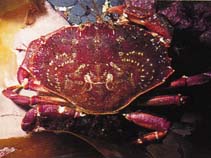Cancer irroratus Say, 1817
Atlantic rock crab| Native range | All suitable habitat | Point map | Year 2050 |

|
| This map was computer-generated and has not yet been reviewed. |
| Cancer irroratus AquaMaps Data sources: GBIF OBIS |
Classification / Names প্রচলিত নাম সমূহ | প্রতিনাম সমূহ | CoL | ITIS | WoRMS
Malacostraca | Decapoda | Cancridae
Environment: milieu / climate zone / গভীরতার পরিসীমা / distribution range বাস্তুসংস্থান
; গভীরতার পরিসীমা 0 - 575 m (সূত্র 367). Temperate, preferred 20°C (সূত্র 107945); 53°N - 25°N, 81°W - 43°W
Distribution দেশ সমূহ | এফ এ ও এলাকাসমূহ | বাস্তুতন্ত্র | দৃষ্টিগোচর | প্রচলন
Western Atlantic.
Length at first maturity / আকৃতি / Weight / Age
পরিপক্কতা : Lm ? range ? - ? cm Max length : 8.9 cm CW (female); সবের্াচ্চ প্রকাশিত ওজন : 0.00 g
Short description বহিঃ অঙ্গ সংস্থান
Life cycle and mating behavior পরিপক্কতা | প্রজনন | ডিম ছাড়া | Eggs | ডিম্বধারন ক্ষমতা | Larvae
Main reference
সূত্র সংখ্যা | সমম্বয়কারী | সহযোগী
Tavares, M. 2003 True Crabs. pp. 327-352. In Carpenter, K.E. (ed.) The living marine resources of the Western Central Atlantic. Volume1: introdution, molluscs, crustaceans, hagfishes, sharks, batoid fishes, and chimaeras. FAO Species Identification Guide for Fishery Purposes and American Society of Ichthyologists and Herpetologists Special PublicationNo. 5. Rome, FAO. pp. 1-600. (সূত্র 367)
IUCN Red List Status
(সূত্র 130435: Version 2025-1)
CITES status (সূত্র 108899)
CMS (সূত্র 116361)
Threat to humans
Human uses
মৎস্য: বাণিজ্যিক
| FishSource | আমাদের চতুর্পাশ্বের সাগর
হাতিয়ার
আরো তথ্য
Max. ages / sizes
Length-weight rel.
Length-length rel.
Length-frequencies
Mass conversion
প্রাচুর্য
ইন্টারনেট সুত্র
BHL | BOLD Systems | CISTI | DiscoverLife | FAO(Publication : search) | Fishipedia | GenBank (genome, nucleotide) | GloBI | Gomexsi | Google Books | Google Scholar | Google | PubMed | জীবন বৃক্ষ | Wikipedia (Go, অনুসন্ধান ) | জুলজিকাল রেকর্ড



